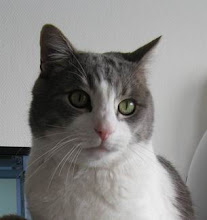It's always good to start the day with sex. Alas, today we were only talking and thinking about it.
One of the big mysteries in evolutionary biology has been how sex evolved. John Maynard Smith pointed out in the 1960s that it really shouldn't have - there's a huge cost to any gene (because with sex it only has a 50% chance of being passed on), so a modifier that stops sex and have a 100% chance of being passed on will be fitter. Since then a lot of people have been worrying about this problem. In her plenary talk, Sally Otto talked about recent work that suggests we are close to a resolution of the problem.
There have been a couple of explanations that have been around for some time. The first is that sex helps evolution because it breaks up bad combinations of genes, particularly when the disadvantages are magnified, so that the cost of carrying two bad genes is more than the cost of carrying one bad gene twice (technically this is called epistasis). This does give sex and advantage, but it's so small, and only occurs in limited and unlikely conditions.
The second explanation is the Red Queen hypothesis, again. A species is being subjected to all sorts of attacks (pathogens, parasites etc.), which are co-evolving with them, so there is a constant arms race (this is the Red Queen bit). A species evolves defences, and sex can help combine them together, to increase the speed at which the species runs away from its enemies. This has some empirical support, but Otto showed that the theoretical results suggested it only worked under a narrow set of circumstances.
She then introduced a third idea - to look at finite populations. All of the previous work she had presented had been done assuming infinite populations. But in a finite population gene combinations can be combined randomly by genetic drift, and also not every combination of genes will be present in the population. Sex can then work to combine gene combinations and give an advantage. Adding the Red Queen improves the advantage (and I suspect that any sort of environmental variation will give an advantage to sex, more work needs to be done etc.).
After the plenary I ran off to the session on integrating evolution and ecology. Lots of different things. Carol Eunmi Lee talked about a lot of work on invasing species (err, were they isopods? Something small and aquatic anyway), and suggested that species that invade tend to live in more variable environments in their core ranges (there was more than this, but I turned off during the physiology). Virpi Lummaa talked about a huge data set on agricultural Finns (the church has kept the records on births marriages and deaths for over 200 years, so they put a few of them in a database), looking at twins. She showed that a female twin is less fit if her sibling was male, and that this was due to conditions in the womb (because it persisted even if the sibling died in the first three months of life).
After the sessions there was the ESEB business meeting. As always with these things, some of it was interesting, some just needed to be said (e.g. the accounts). A couple of interesting things appeared from the meeting - the SSE (our US counterparts) wanted to orgnaise a joint meeting. One option had been to have it in 2011, when there should be an ESEB meeting. Nobody liked that, but the second option was to to have a meeting in 2012 in Canada. This looks like the option that will be followed up, so we'll see what happens. The other thing is that there will be a new journal starting next year called Evolutionary Applications.
Today's the last day, and is followed by the banquet. Tomorrow I have to get an early train to go to Gotland, so there may not be any report for a few days.
Saturday, 25 August 2007
ESEB: Friday. Starts with sex, ends with Aussie Rules
Posted by
Bob O'Hara
at
08:47
![]()
Labels: conference, ESEB, evolution
Subscribe to:
Post Comments (Atom)

No comments:
Post a Comment